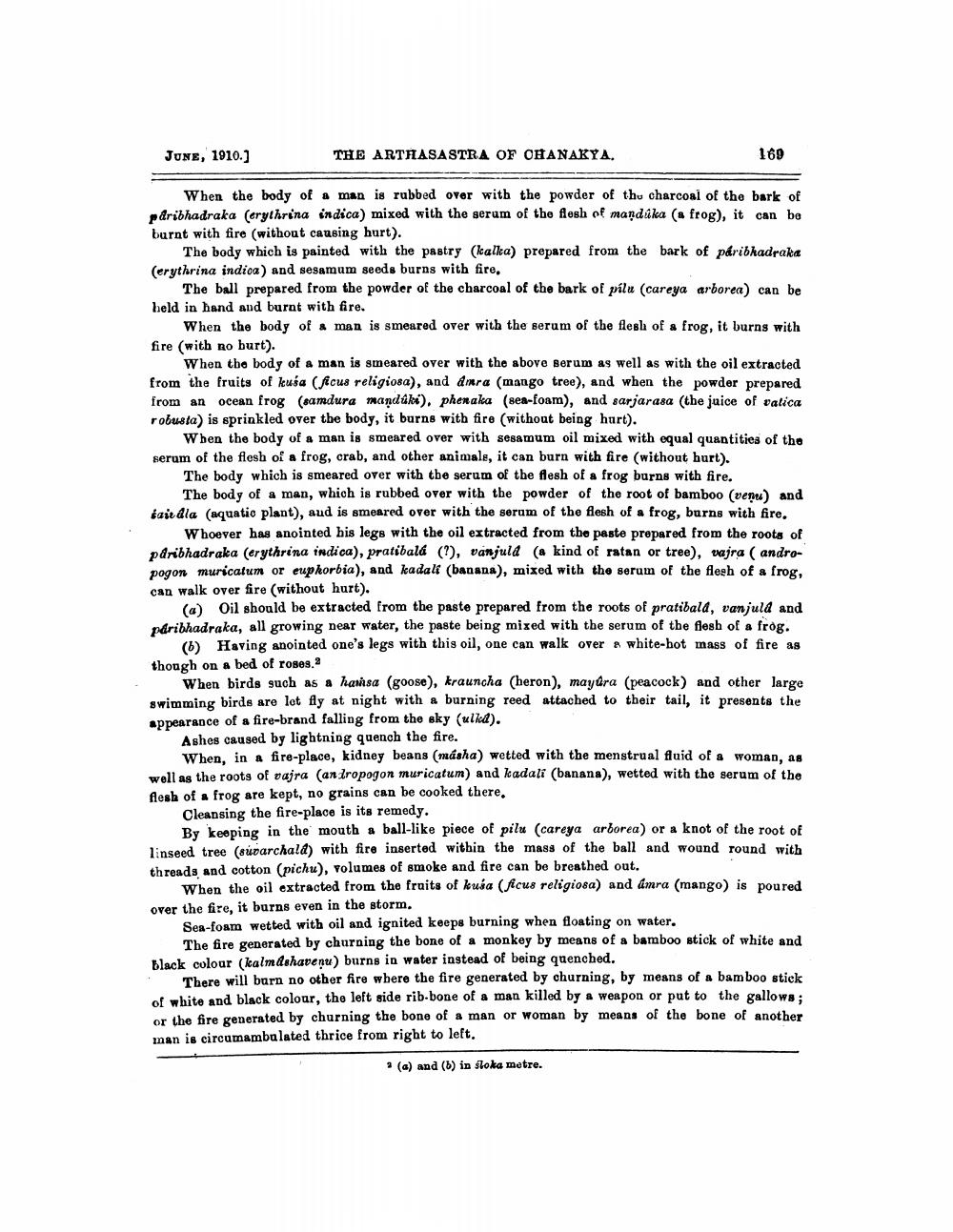________________
JUNE, 1910.)
THE ARTHASASTRA OF CHANAKYA.
169
When the body of a man is rubbed over with the powder of thu charcoal of the bark of paribhadraka (erythrina indica) mixed with the serum of the flesh of mandůka (a frog), it can be burnt with fire (without causing hurt).
The body which is painted with the pastry (kalka) prepared from the bark of paribhadraka (erythrina indica) and sesamum seeds burns with fire.
The ball prepared from the powder of the charcoal of the bark of pílu (careya arborea) can be held in hand and burnt with fire.
When the body of a man is smeared over with the serum of the flesh of a frog, it burns with fire (with no burt).
When the body of a man is smeared over with the above serum as well as with the oil extracted from the fruits of kusa (fcus religiosa), and drra (mango tree), and when the powder prepared from an ocean frog (samdura mandúki), pheraka (sea-foam), and sarjarasa (the juice of valica robusta) is sprinkled over the body, it burns with fire (without being hurt).
When the body of a man is smeared over with sesamum oil mixed with equal quantities of the serum of the flesh of a frog, crab, and other animals, it can burn with fire (without hurt).
The body which is smeared over with the serum of the flesh of a frog burns with fire.
The body of a man, which is rubbed over with the powder of the root of bamboo (venu) and fait dla (aquatic plant), aud is smeared over with the seram of the flesh of a frog, burns with fire.
Whoever has anointed his legs with the oil extracted from the paste prepared from the roots of paribhadraka (erythrina indica), pratibala (?), vanjula (a kind of ratan or tree), vajra (andropogon muricatum or euphorbia), and kadali (banana), mixed with the serum of the flesh of a frog, can walk over fire (without hurt).
Oil should be extracted from the paste prepared from the roots of pratibald, van juld and paribhadraka, all growing near water, the paste being mixed with the serum of the flesh of a frog.
(6) Having anointed one's legs with this oil, one can walk over a white-hot mass of fire ag though on a bed of roses.
When birds such as a hamsa (goose), krauncha (heron), mayura (peacock) and other large swimming birds are lot fly at night with a burning reed attached to their tail, it presents the appearance of a fire-brand falling from the sky (ulked).
Ashes caused by lightning quench the fire.
When, in a fire-place, kidney beans (másha) wetted with the menstrual fluid of a woman, as well as the roots of vajra (an Iropogon muricatum) and kadali (banana), wetted with the serum of the flesh of a frog are kept, no grains can be cooked there.
Cleansing the fire-place is its remedy.
By keeping in the mouth a ball-like piece of pilu (careya arborea) or a knot of the root of linseed tree (súčarchald) with fire inserted within the mass of the ball and wound round with threads and cotton (pichu), volumes of smoke and fire can be breathed out.
When the oil extracted from the fruits of kuia (ficus religiosa) and Amra (mango) is poured over the fire, it burns even in the storm.
Sen-foam wetted with oil and ignited keeps burning when floating on water.
The fire generated by churning the bone of a monkey by means of a bamboo stick of white and black colour (kalmdshaveņu) burns in water instead of being quenched.
There will burn no other fire where the fire generated by churning, by means of a bamboo stick of white and black colour, the left side rib-bone of a man killed by a weapon or put to the gallows; or the fire generated by churning the bone of a man or woman by means of the bone of another man is circumambulated thrice from right to left.
(a) and (b) in sloka metre.




